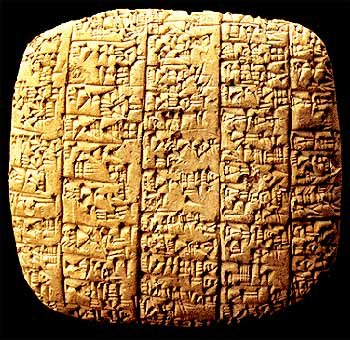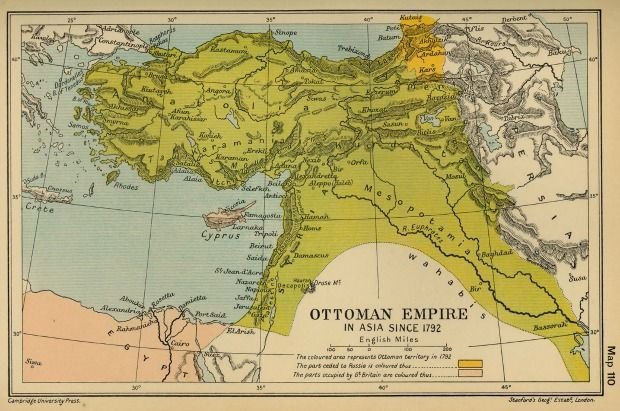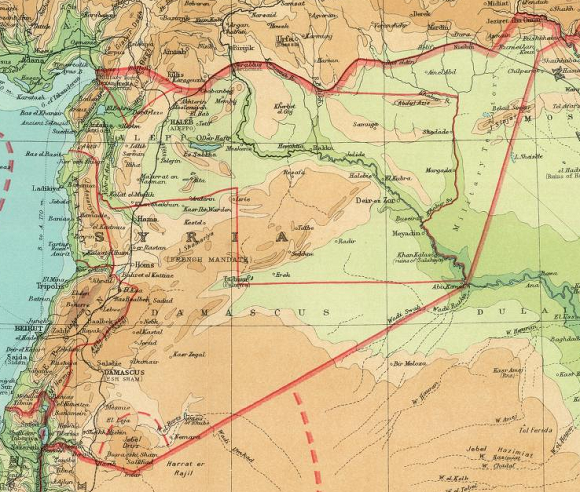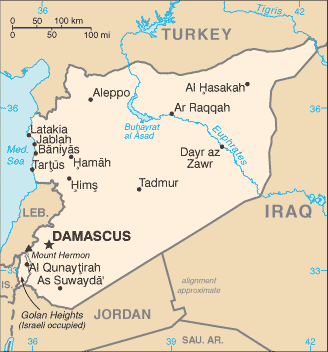The ancient era
Archaeologists believe the original civilization in Syria was one of the most ancient on earth. Seeing as it’s part of the Fertile Crescent, where some of the first people on earth practiced cattle breeding and agriculture, the land is chock-full of neolithic remains.
Syria is home to one of the oldest cities ever excavated—Ebla, believed to exist around 3,000 BCE, is where people spoke one of the oldest known written languages.

This sought-after land was occupied by all sorts of ancient empires—the Egyptians, Hittites, Sumerians, Mitanni, Assyrians, Babylonians, Canaanites, Phoenicians, Arameans, Amorites, Persians, and eventually, Greeks with the conquest of Alexander the Great (‘Syria’ means ‘formerly Assyria’ in ancient Greek, and it’s assumed this is when the area was given its name). Several hundred years later, Pompey the Great captured the Greek capital of Antioch (now part of Turkey, but what was once Syria), turning it into a Roman province. Syria has a vastly diverse beginning.
Syria is also important in early Christian Church history—Paul the Apostle converted on the road to Damascus and was a significant figure at the local church in Antioch, where people were first called Christians

When the Roman Empire declined, Syria became part of the eastern half, better known as the Byzantine Empire, around 395 CE. Several hundred years later, it was conquered by Muslim Arabs, transferring power to the Islamic Empire.
Damascus was its capital and the empire spread far and wide, making the city prosperous—ancient palaces and mosques still stand from the era. It is believed that Christians lived in Syria peacefully during the early years of the empire, and several held governmental posts.
The middle ages
In 750, the Empire’s capital was moved to Baghdad and the Syrian territory weakened, and eventually, the land was in turmoil between the Hamdanids, Byzantines, and Fatimids, all who wanted to rule the area. The Byzantines eventually won out, but things were still chaotic for hundreds of years. Eventually, Syria was conquered by the Seljuk Turks and then the Ayyubid dynasty of Egypt in 1185.
For the next several centuries, Syria was held by Crusader states, Mongols, Egyptians, Mamluks, and in 1400, Timur Lenk (a Turko-Mongol general from Central Asia) captured Damascus, where many of the people were massacred and the Christian population suffered persecution. (Oddly enough, the artisans were spared and deported to Samarkand.)
Got all this so far?

In 1516, Syria was conquered by the Ottoman Empire, and it remained part until its collapse in 1918. There was peace during most of these centuries. Syrian territory constituted modern-day Syria, Lebanon, Israel, Jordan, Palestinian Authority, Gaza Strip, and parts of Turkey and Iraq.
The 20th century
In 1916, the Sykes-Picot Agreement from World War I secretly divided the Ottoman Empire into zones, and in 1918, when Arab and British troops captured Damascus and Aleppo, Syria became a League of Nations mandate and moved under French control in 1920.

A large number of Syrians weren’t thrilled with the sudden French Mandate, and in 1925 a revolt broke out, spreading into Lebanon, but was suppressed in 1926. In 1928 elections were held for a constituent assembly, which included a Syrian constitution, but France rejected the idea, leading to more protests.
france syria treatyEventually, in 1936, France and Syria negotiated a treaty of independence, allowing Syria to maintain independence in theory, even though France held military and economic dominance. But the French never ratified the treaty, and when they themselves were captured in 1940 during World War II, Syria was briefly held by Vichy France (axis-controlled) until British occupied the land in 1941.
Syria was finally recognized as an independent republic in 1944, and the French military eventually left by 1946. It became officially independent on April 17, 1946, but between then and the late 50s, it had 20 different cabinets and four constitutions. Not a very stable government, to say the least.
In 1948 Syria got involved in the Arab-Israeli War out of protest from the establishment of Israel, and once the demilitarized zone under UN supervision was established, future Syrian-Israel negotiations became volatile (and remain heavily so since). Many Syrian Jews left the country.
There were three (three!) military coup d’etats in 1949, leading to a fourth coup in 1954 (the first one is considered the first military overthrow in the post-World War II Arab world).

For most of the 20th century, Syria’s power remained in its military and not so much in its parliament. Because of the Suez Crisis in 1956, Syria signed a pact with the Soviet Union, allowing a Communist foothold in the government in exchange for military equipment. This angered neighboring Turkey, but brought Syria closer to Egypt because of their socialist leanings at the time.
Egypt and Syria decided to merge and become the United Arab Republic, but the idea lasted only a few years because of Egypt’s dominance. Syria broke ties and became the Syrian Arab Republic, and most of the 60s were characterized by frequent coups, military revolts, bloody riots, and civil disorders. There were also tons of issues involving the demilitarized zone in Israel and their occupation of Golan Heights, and they leaned closer and closer toward a socialist regime with Soviet blocs as their allies.
Eventually, the Minister of Defense, a guy named Hafez al-Assad, seized power in a bloodless coup in 1970, and thus began a new era for 30 years.
The Assad era

So Syria’s history might be confusing so far—but now this is where things get really complicated. Shortly after gaining power, Assad created a new legislature and local councils to govern smaller provinces, consolidated political parties, wrote a new constitution (again), declared Syria a secular socialist state with Islam as the majority religion, and launched a surprise attack on Israel with Egypt.
Shortly after, Syria got involved in Lebanon’s civil war, which basically led to a 30-year Syrian military occupation. Assad had his critics, but open dissent was “repressed.” There was an assassination attempt in 1980, and in 1982 between 10,000 and 25,000 civilians were killed or wounded by artillery fire in Hama in a battle against the Muslim Brotherhood.
Syria joined the US-led coalition against Iraq in 1990, leading to better relations in the West, but when Assad died in 2000, his son Bashar al-Assad became his successor at age 34 (parliament quickly changed the mandatory minimum age of the President from 40 so that he could take charge). He officially ran for president, but he ran unopposed and earned 97.3% of the vote.

People were initially positive at the start of his regime, and even called this super-short era Damascus Spring, hopeful there would be change in the dictatorial style of leadership from his father. Assad released 600 political prisoners, and Pope John Paul II visited a few months later.
But only one year later, pro-reform movements were suppressed, leading intellectuals were arrested, and in 2002, the U.S. officially accused Syria of acquiring weapons of mass destruction and included them in their list of “axis of evil” countries. Syria was accused of being behind the assassination of the Lebanese prime minister in 2005.
Over the next few years, Internet censorship tightened, and though things were slowly looking up in its relationship with western countries and the EU, all that was set back (again) when Israel led an air strike in northern Syria on what they claimed was a nuclear facility constructed with North Korea’s help.

In 2008, Assad met with French president Nicolas Sarkozy and the new Lebanese president Michel Suleiman, laying down foundations for better diplomacy between the countries, and they even hosted a summit including Turkey and Qatar with the goal of Middle East peace. And in 2009, the US sent a special envoy to negotiate peace talks and posted its first ambassador in five years.
All this progress came to an abrupt end, however, when in 2010, the U.S. renewed economic sanctions against Syria, accusing it of supporting terrorist groups (Hamas, Hezbollah, al Qaeda, and the like), and a year later, the UN basically said the same thing.
Remember part of the Arab Spring in early 2011, when Egypt protested and successfully changed its governments’ regime? Well, that gave Syrian civilians courage to try and do the same. Unfortunately, though, the Syrian government did not respond peacefully.

That brings us to all the craziness happening in Syria the past two years—and where I’m going to leave off trying to explain things. However, this is a fantastic, easy-to-read article that explains what’s going on right now—I highly recommend reading it after you finish this one.
So… there you have it. A brief history of one of the oldest countries in existence. So many layers of culture and civilizations, and yet a country filled with repeat stories pursuing dominance, control, and power. Learning and writing all this has been a sobering reminder to keep doing what we all need to do daily: pray for peace.
Things are a mess there.
Hi! I am a robot. I just upvoted you! I found similar content that readers might be interested in:
https://theartofsimple.net/a-brief-history-of-syria/